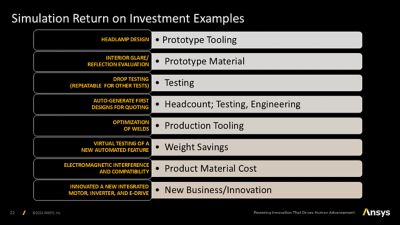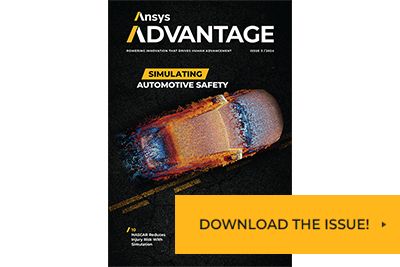-
United States -
United Kingdom -
India -
France -
Deutschland -
Italia -
日本 -
대한민국 -
中国 -
台灣
-
Ansys is committed to setting today's students up for success, by providing free simulation engineering software to students.
-
Ansys is committed to setting today's students up for success, by providing free simulation engineering software to students.
-
Ansys is committed to setting today's students up for success, by providing free simulation engineering software to students.
-
Contact Us -
Careers -
Students and Academic -
For United States and Canada
+1 844.462.6797

The transportation industry faces cost and time-to-market pressures even as it drives to develop complex innovations in areas such as software-defined vehicles, electric powertrains, and advanced driver-assistance system (ADAS) platforms. That means automotive engineering resources are stretched thin as interdependent system complexity balloons and everyone asks engineers to go faster. Achieving those competing goals while improving safety would be impossible without simulation-enabled digital engineering. Let me explain why.
Improve Speed and Safety
Not too long ago, we were comfortable taking four years to develop a large vehicle program. That is no longer competitive. Original equipment manufacturers are now aiming to develop vehicles in two years or less.
However, the latest data shows that vehicle programs are actually being delayed. Over half of the vehicle programs in the U.S. were delayed last year. This is a significant trend we’ve been tracking over the past seven years. Some programs are delayed due to market-based decision changes, but many delays are caused by poor launch execution. Could it be that initiatives to increase automotive technology everywhere from the drivetrain to lighting are becoming too complicated? Something needs to change, as delayed launches have a large impact on profit.
Simulation is a critical element of that change. It has kept pace with the ever-growing needs of the automotive industry over the years. For example, crash analysis in the 1990s analyzed details of a crash with a 12,000-cell mesh. With our latest innovations, we are analyzing over 20 million elements. And we’re doing it faster than ever with software that takes advantage of the latest innovations in cloud computing and graphics processing units.
Another example can be found in human body modeling. Crash testing includes more load cases and crash scenarios than ever, adding to the complexity. For years, we primarily counted on crash test dummies that, too, have become much more sophisticated and expensive over time. We can now realize the benefits of having sophisticated virtual human body models.
We continually add simulation models to our crash library. For example, we are adding detailed models for connections. Are you considering a MIG weld, a spot weld, or adhesives? Are you using composites or recycled materials? These have been traditionally difficult to simulate because of their random nature. We now have established correlated models for these materials.

“New technologies are not able to be developed alone within a single team; these technologies are interdependent, so teams that haven’t collaborated in the past will need to do so now.”
— Judy Curran, senior chief technology officer, automotive and transportation, Ansys
From materials, to crash safety, to smart lighting, simulation enables engineers to rise to industry challenges by designing and validating new features without expensive hardware testing. You can even compress design cycles by combining simulation with artificial intelligence to meet evolving requirements and introduce new products.

Enable Digital Engineering
Going faster requires a development process that is in a digital environment. At Ansys, we have a framework that will make it possible to integrate our technology and tools with your people, existing processes, and data to accelerate the product development process.
New technologies are not able to be developed alone within a single team; these technologies are interdependent, so teams that haven’t collaborated in the past will need to do so now.
ADAS functions are a great example of interdependencies. How an ADAS controls steering, brakes, and lighting can help prevent or reduce the severity of an upcoming crash. The same goes for the battery team working with the body structure team. That’s why it’s critical to make it easier to co-simulate among teams.
Collaborating in the same digital environment can help teams optimize design options for improved safety. Ansys champions open workflows so that our products can be integrated into a more complete digital thread.
As the transportation industry evolves and innovates to deliver upon the goals of clean and safe mobility, efficient engineering processes are critical. Simulation is a key enabler in shortening engineering processes and making them more efficient. Visionary automotive companies know how their world-changing ideas will perform well before prototypes and production through the use of simulation and model-based systems engineering. No longer relegated to CAE departments, simulation has changed tremendously over the past few years, empowering every engineer to innovate faster than ever before.

Lower Costs and Risks
Digital engineering requires an investment but one that has obvious returns. Simulation is one of the most significant enablers of time and cost savings, yet to realize those savings requires an agreement to cut some of the traditional engineering process expenses: engineering material cost, prototype cost, test headcount, test facilities, prototype tooling, production tooling modifications, etc.
You can increase safety and mitigate risks by quickly assessing many scenarios in a virtual environment, but simulation also saves opportunity costs. Traditional prototype and testing regimes may allow an engineer to perform half a dozen tests, but with simulation that same engineer can perform thousands of tests in the same amount of time. That means edge cases, wild ideas, and retesting unexpected outcomes are all benefits of simulation. When it comes to simulation, companies that defer expenditures to next year will find themselves another year behind.
To learn more, read the Simulating Automotive Safety issue of Ansys Advantage magazine.
Just for you. We have some additional resources you may enjoy.
The Advantage Blog
The Ansys Advantage blog, featuring contributions from Ansys and other technology experts, keeps you updated on how Ansys simulation is powering innovation that drives human advancement.
















